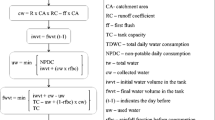Abstract
This research evaluates which is the most cost-efficient rainwater harvesting (RWH) system in a new commercial building located in the north of Portugal, in Braga. Based on the economic analysis, the cost-efficiency of the presented RWH strategies may be considered for the case studied.
The results of this research indicate that RWH scenarios proposed are cost-efficient. Considering a 10 % discount rate, the water price charge in the municipally of Braga and the cost of the infrastructures would be enough to make RWH cost-efficient for this option. At this discount rate, the payback period ranges from 2 to 6 years and the internal rate of return would range from 23 to 76 %. If a discount rate of 5 % were considered, the payback periods would be reduced by approximately 1 year.

Similar content being viewed by others
References
Agere - empresa de águas, efluentes e resíduos de Braga (2013) http://www.agere.pt/web1/zp/tpl1/id1/paginas/ficha.asp?p_case=2&p_cod_elemento=91
ANQIP (2009) ETA 0701 - Sistemas de Abastecimento de Águas Pluviais em Edifícios (SAAP) (in portuguese): Portuguese National Association for Quality in Building Services - ANQIP, Version 7
BSI (2009) BS 8515:2009 rainwater harvesting systems - code of practice. British Standard Institution. Reino Unido, UK
Chilton JC, Maidment GG, Marriott D, Francis A, Tobias G (2000) Case study of a rainwater harvesting system in a commercial building with a large roof. Urban Water 1(4):345–354
Coombes P, Kuczera G (2003) Analysis of the performance of rainwater tanks in Australian capital cities. 28th International Hydrology and Water Resources Symposium, Wollongong, NSW, Australia
Corbitt RA (1998) Standard handbook of environmental engineering, 2nd edn. McGraw-Hill, New York
EEA (2009) EEA signals 2009: key environmental issues facing Europe. European Environment Agency. Copenhagen. 38 pp. ISBN 978-92-9167-391-9
Environmental Agency UK (2008) Harvesting rain water for domestic uses: an information guide
European Commission, Directorate General Regional Policy, Guide to COST-BENEFIT ANALYSIS of investment projects Structural Funds, Cohesion Fund and Instrument for Pre-Accession 2008, http://ec.europa.eu/regional_policy/sources/docgener/guides/cost/guide2008_en.pdf
Farrency R, Gabarrell X, Rieradevall J (2011) Cost-efficiency of rainwater harvesting strategies in dense Mediterranean neighbourhoods. Resour Conserv Recycl 55:686–694
fbr (2002) Translation of DIN 1989–1:2001–10. Rainwater harvesting systems – Part 1: Planning, installation, operation and maintenance. Fachvereinigung Betriebs - und Regenwassernutzung e.V. Darmstadt, Germany. 34 pp
Ghisi E, Tavares DF, Rocha VL (2009) Rainwater harvesting in petrol stations in Brasilia: potential for potable water savings and investment feasibility analysis. Resour Conserv Recycl 54:79–85
Ghisi E, Schondermark PN (2013) Investment feasilibility analysis of rainwater use in residences. Water Resour Manag 27:2555–2576. doi 10.1007/s11269-013-0303-6. http://publications.environment-agency.gov.uk/pdf/GEHO0108BNPN-E-E.pdf (accessed 10.11.10).
Ghisi E, Montibeller A, Schmidt RW (2006) Potential for potable water savings by using rainwater: an analysis over 62 cities in southern Brazil. Build Environ 41(2):204–10
Ghisi E, Bressan DL, Martini M (2007) Rainwater tank capacity and potential for potable water savings by using rainwater in the residential sector of southeastern Brazil. Build Environ 42(4):1654–66
Imteaz MA, Shanableh A, Rahman A, Ahsan A (2011) Optimisation of rainwater tank design from large roofs: a case study in Melbourne, Australia. Resour Conserv Recycl 55(11):1022–9
Imteaz MA, Adeboye O, Rayburg S, Shanableh A (2012) Rainwater harvesting potential for southwest Nigeria using daily water balance model. Resour Conserv Recycl 62:51–55. doi:10.1016/j.resconrec.2012.02.007
Khastagir A, Jayasuriya N (2011) Investment evaluation of rainwater tanks. Water Resour Manag 25:3769–3784. doi:10.1007/s11269-011-9883-1
Matos C, Santos C, Pereira S, Bentes I, Imteaz M (2014) Rainwater storage tank sizing: case study of a commercial building. Int J Sustain Built Environ. doi:10.1016/j.ijsbe.2014.04.004
Melo-Batista J (2002) A melhoria da eficiência do uso eficiente da água como contributo para a sustentabilidade dos recursos naturais 10 Encontro Nacional de Saneamento Básico: Uso sustentável da água: situação portuguesa e perspectivas de futuro
Mun JS, Han MY (2012) Design and operational parameters of a rooftop rainwater harvesting system: definition, sensitivity and verification. J Environ Manage 93:147–153
Muthukumaran S, Baskaran K, Sexton N (2011) Quantification of potable water savings by residential water conservation and reuse—a case study. Resour Conserv Recycl 55:945–52
Ruegg RT, Marshall HE (1990) Building economics—theory and pratice. Van Nastrand Reinhold, New York
Santos C, Taveira-Pinto F (2013) Analysis of different criteria to size rainwater storage tanks using detailed methods. Resour Conserv Recycl 71:1–6
Villarreal EL, Dixon A (2005) Analysis of a rainwater collection system for domestic water supply in Ringdansen, Norrkoping, Sweden. Build Environ 40:1174–1184
Zhang Y, Chen D, Chen L, Ashbolt S (2009) Potencial for rainwater use in high-rise buildings in Australian cities. J Environ Manage 91:222–226
Acknowledgments
The authors are grateful to Eng. Helder Ferreira, an ex-student from University of Trás-os-Montes and Alto Douro and to Dolce Vita Braga shopping centre for all the support in many aspects of this research.
Author information
Authors and Affiliations
Corresponding author
Rights and permissions
About this article
Cite this article
Matos, C., Bentes, I., Santos, C. et al. Economic Analysis of a Rainwater Harvesting System in a Commercial Building. Water Resour Manage 29, 3971–3986 (2015). https://doi.org/10.1007/s11269-015-1040-9
Received:
Accepted:
Published:
Issue Date:
DOI: https://doi.org/10.1007/s11269-015-1040-9




